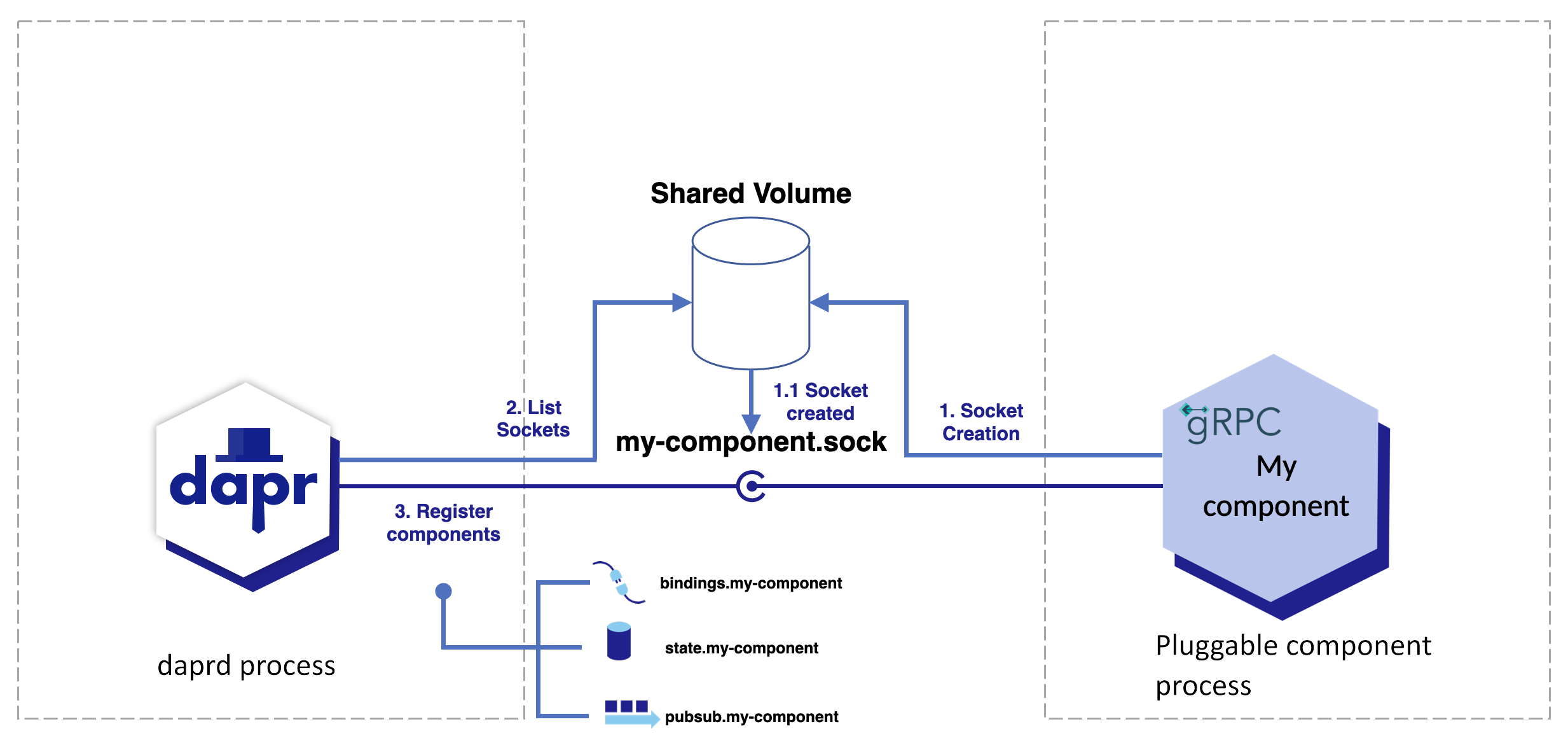The documentation you are viewing is for Dapr v1.15 which is an older version of Dapr. For up-to-date documentation, see the latest version.
如何:注册一个可插拔组件
组件注册过程
使用 gRPC 的可插拔组件通常作为容器或进程运行,需要通过Unix 域套接字(简称 UDS)与 Dapr 运行时通信。它们会通过以下步骤自动被发现并注册到运行时中:
- 组件监听放置在共享卷上的Unix 域套接字。
- Dapr 运行时列出共享卷中的所有Unix 域套接字。
- Dapr 运行时连接每个套接字,并使用 gRPC 反射从组件实现的给定构建块 API 中发现所有 proto 服务。
一个组件可以同时实现多个组件接口。

虽然 Dapr 的内置组件已经集成在运行时中,但可插拔组件在与 Dapr 一起使用之前需要进行一些设置步骤。
- 可插拔组件需要在 Dapr 本身启动之前启动并准备好接收请求。
- 用于可插拔组件通信的Unix 域套接字文件需要对 Dapr 和可插拔组件都可访问。
在独立模式下,可插拔组件可以作为进程或容器运行。在 Kubernetes 上,可插拔组件作为容器运行,并由 Dapr 的 sidecar 注入器自动注入到应用程序的 pod 中,允许通过标准的Kubernetes 容器规范进行自定义。
这也改变了在 Dapr 和可插拔组件之间共享Unix 域套接字文件的方法。
注意
作为前提条件,操作系统必须支持 Unix 域套接字,任何 UNIX 或类 UNIX 系统(Mac、Linux 或用于本地开发的 WSL 对于 Windows 用户)都应该足够。选择您的环境以开始使您的组件可被发现。
运行组件
在 Dapr 启动之前,您的组件和 Unix 套接字必须正在运行。
默认情况下,Dapr sidecar 在 /tmp/dapr-components-sockets 中查找作为Unix 域套接字文件的组件。
此文件夹中的文件名对于组件注册很重要。它们必须通过附加组件的名称和您选择的文件扩展名(通常为 .sock)来形成。例如,文件名 my-component.sock 是一个有效的 Unix 域套接字文件名,适用于名为 my-component 的组件。
由于您在与组件相同的主机上运行 Dapr,请验证此文件夹及其中的文件是否可被您的组件和 Dapr 访问和写入。如果您使用 Dapr 的 sidecar 注入器功能,则此卷会自动创建和挂载。
组件发现和多路复用
通过Unix 域套接字(UDS)可访问的可插拔组件可以托管多个不同的组件 API。在组件的初始发现过程中,Dapr 使用反射枚举 UDS 后面的所有组件 API。上例中的 my-component 可插拔组件可以包含状态存储(state)和 pub/sub(pubsub)组件 API。
通常,可插拔组件实现单个组件 API 以进行打包和部署。然而,以增加其依赖性和扩大其安全攻击面为代价,可插拔组件可以实现多个组件 API。这可以减轻部署和监控负担。隔离、容错和安全的最佳实践是为每个可插拔组件实现单个组件 API。
定义组件
使用组件规范定义您的组件。组件的 spec.type 值是通过以下两个部分与 . 连接而成的:
- 组件的 API(
state、pubsub、bindings等) - 组件的名称,它是从Unix 域套接字文件名中派生的,不包括文件扩展名。
您需要为可插拔组件的Unix 域套接字公开的每个 API 定义一个组件规范。前面示例中的 Unix 域套接字 my-component.sock 公开了一个名为 my-component 的可插拔组件,具有 state 和 pubsub API。需要两个组件规范,每个规范在其自己的 YAML 文件中,放置在 resources-path 中:一个用于 state.my-component,另一个用于 pubsub.my-component。
例如,state.my-component 的组件规范可以是:
apiVersion: dapr.io/v1alpha1
kind: Component
metadata:
name: my-production-state-store
spec:
type: state.my-component
version: v1
metadata:
在上面的示例中,请注意以下几点:
- 字段
spec.type的内容是state.my-component,指的是作为名为my-component的可插拔组件公开的状态存储。 - 字段
metadata.name,即此处定义的状态存储的名称,与可插拔组件名称无关。
将此文件保存为 Dapr 的组件配置文件夹中的 component.yaml。就像 metadata.name 字段的内容一样,此 YAML 文件的文件名没有影响,也不依赖于可插拔组件名称。
运行 Dapr
初始化 Dapr,并确保您的组件文件放置在正确的文件夹中。
注意
Dapr 1.9.0 是支持可插拔组件的最低版本。从 1.11.0 版本开始,支持可插拔组件的容器自动注入。
就是这样!现在您可以通过 Dapr API 调用状态存储 API。通过运行以下命令查看其运行情况。用 Dapr HTTP 端口替换 $PORT:
curl -X POST -H "Content-Type: application/json" -d '[{ "key": "name", "value": "Bruce Wayne", "metadata": {}}]' http://localhost:$PORT/v1.0/state/prod-mystore
检索值,用 Dapr HTTP 端口替换 $PORT:
curl http://localhost:$PORT/v1.0/state/prod-mystore/name
为您的可插拔组件构建和发布容器
确保您的组件作为容器运行,首先发布并可被您的 Kubernetes 集群访问。
在 Kubernetes 集群上部署 Dapr
按照在 Kubernetes 集群上部署 Dapr文档中提供的步骤进行操作。
在您的部署中添加可插拔组件容器
可插拔组件作为容器在与您的应用程序相同的 pod 中部署。
由于可插拔组件由Unix 域套接字支持,请使您的可插拔组件创建的套接字可被 Dapr 运行时访问。配置部署规范以:
- 挂载卷
- 提示 Dapr 挂载的 Unix 套接字卷位置
- 将卷附加到您的可插拔组件容器
在以下示例中,您配置的可插拔组件作为容器部署在与您的应用程序容器相同的 pod 中。
apiVersion: apps/v1
kind: Deployment
metadata:
name: app
labels:
app: app
spec:
replicas: 1
selector:
matchLabels:
app: app
template:
metadata:
labels:
app: app
annotations:
# 推荐自动注入可插拔组件。
dapr.io/inject-pluggable-components: "true"
dapr.io/app-id: "my-app"
dapr.io/enabled: "true"
spec:
containers:
# 您的应用程序的容器规范,照常。
- name: app
image: YOUR_APP_IMAGE:YOUR_APP_IMAGE_VERSION
建议将 dapr.io/inject-pluggable-components 注释设置为 “true”,指示 Dapr 的 sidecar 注入器该应用程序的 pod 将有额外的容器用于可插拔组件。
或者,您可以跳过 Dapr 的 sidecar 注入功能,手动添加可插拔组件的容器并注释您的 pod,告诉 Dapr 该 pod 中哪些容器是可插拔组件,如下例所示:
apiVersion: apps/v1
kind: Deployment
metadata:
name: app
labels:
app: app
spec:
replicas: 1
selector:
matchLabels:
app: app
template:
metadata:
labels:
app: app
annotations:
dapr.io/pluggable-components: "component" ## 可插拔组件容器的名称,用 `,` 分隔,例如 "componentA,componentB"。
dapr.io/app-id: "my-app"
dapr.io/enabled: "true"
spec:
containers:
### --------------------- 您的应用程序容器在此处 -----------
- name: app
image: YOUR_APP_IMAGE:YOUR_APP_IMAGE_VERSION
### --------------------- 您的可插拔组件容器在此处 -----------
- name: component
image: YOUR_IMAGE_GOES_HERE:YOUR_IMAGE_VERSION
在应用部署之前,让我们再添加一个配置:组件规范。
定义组件
可插拔组件使用组件规范定义。组件 type 是从套接字名称(不带文件扩展名)派生的。在以下示例 YAML 中,替换:
your_socket_goes_here为您的组件套接字名称(无扩展名)your_component_type为您的组件类型
apiVersion: dapr.io/v1alpha1
kind: Component
metadata:
name: prod-mystore
# 在 Kubernetes 上运行并自动容器注入时,添加以下注释:
annotations:
dapr.io/component-container: >
{
"name": "my-component",
"image": "<registry>/<image_name>:<image_tag>"
}
spec:
type: your_component_type.your_socket_goes_here
version: v1
metadata:
scopes:
- backend
当您希望 Dapr 的 sidecar 注入器处理可插拔组件的容器和卷注入时,dapr.io/component-container 注释在 Kubernetes 上是必需的。至少,您需要 name 和 image 属性,以便 Dapr 的 sidecar 注入器成功将容器添加到应用程序的 pod 中。Unix 域套接字的卷由 Dapr 的 sidecar 注入器自动创建和挂载。
范围您的组件,以确保只有目标应用程序可以连接到可插拔组件,因为它只会在其部署中运行。否则,运行时在初始化组件时会失败。
就是这样!将创建的清单应用到您的 Kubernetes 集群,并通过 Dapr API 调用状态存储 API。
使用Kubernetes pod 转发器访问 daprd 运行时。
通过运行以下命令查看其运行情况。用 Dapr HTTP 端口替换 $PORT:
curl -X POST -H "Content-Type: application/json" -d '[{ "key": "name", "value": "Bruce Wayne", "metadata": {}}]' http://localhost:$PORT/v1.0/state/prod-mystore
检索值,用 Dapr HTTP 端口替换 $PORT:
curl http://localhost:$PORT/v1.0/state/prod-mystore/name
下一步
使用此示例代码开始开发 .NET 可插拔组件
Feedback
Was this page helpful?
Glad to hear it! Please tell us how we can improve.
Sorry to hear that. Please tell us how we can improve.